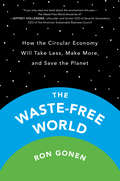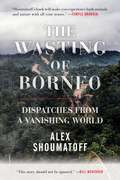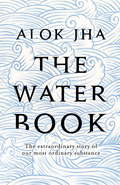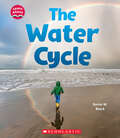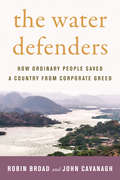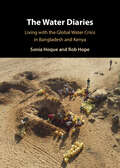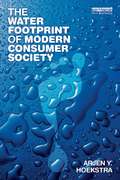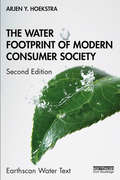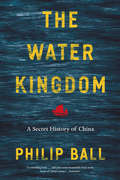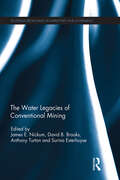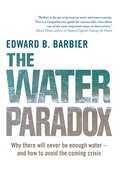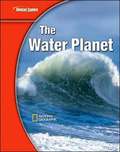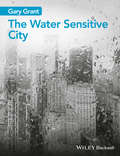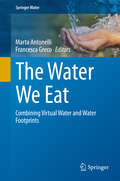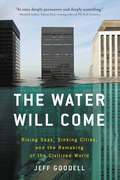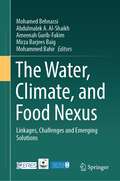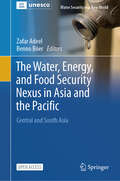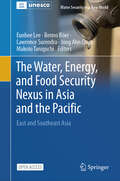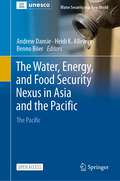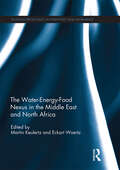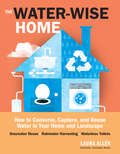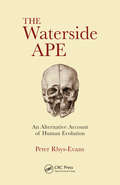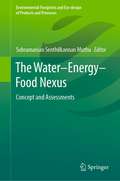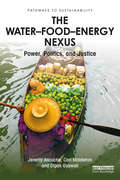- Table View
- List View
The Waste-Free World: How the Circular Economy Will Take Less, Make More, and Save the Planet
by Ron GonenThe next revolution in business will provide for a sustainable future, from founder, CEO and circular economy expert Ron GonenOur take-make-waste economy has cost consumers and taxpayers billions while cheating us out of a habitable planet. But it doesn&’t have to be this way. The Waste-Free World makes a persuasive, forward-looking case for a circular economic model, a &“closed-loop&” system that wastes no natural resources. Entrepreneur, CEO and sustainability expert Ron Gonen argues that circularity is not only crucial for the planet but holds immense business opportunity. As the founder of an investment firm focused on the circular economy, Gonen reveals brilliant innovations emerging worldwide— &“smart&” packaging, robotics that optimize recycling, nutrient rich fabrics, technologies that convert food waste into energy for your home, and many more. Drawing on his experience in technology, business, and city government and interviews with leading entrepreneurs and top companies, he introduces a vital and growing movement. The Waste-Free World invites us all to take part in a sustainable and prosperous future where companies foster innovation, investors recognize long term value creation, and consumers can align their values with the products they buy.
The Wasting of Borneo: Dispatches from a Vanishing World
by Alex ShoumatoffAcclaimed naturalist Alex Shoumatoff issues a worldwide call to protect the drastically endangered rainforests of BorneoIn his eleventh book, but his first in almost two decades, seasoned travel writer Alex Shoumatoff takes readers on a journey from the woods of rural New York to the rain forests of the Amazon and Borneo, documenting both the abundance of life and the threats to these vanishing Edens in a wide-ranging narrative.Alex and his best friend, Davie, spent their formative years in the forest of Bedford, New York. As adults they grew apart, but bonded by the “imaginary jungle” of their childhood, Alex and Davie reunited fifty years later for a trip to a real jungle, in the heart of Borneo. During the intervening years, Alex had become an author and literary journalist, traveling the world to bring to light places, animals, and indigenous cultures in peril. The two reconnect and spend three weeks together on Borneo, one of the most imperiled ecosystems on earth. Insatiable demand for the palm oil ubiquitous in consumer goods is wiping out the world’s most ancient and species-rich rain forest, home to the orangutan and countless other life-forms, including the Penan people, with whom Alex and Davie camp. The Penan have been living in Borneo’s rain forest for millennia, but 90 percent of the lowland rain forest has already been logged and burned to make way for vast oil-palm plantations. Among the most endangered tribal people on earth, the Penan are fighting for their right to exist.Shoumatoff condenses a lifetime of learning about what binds humans to animals, nature, and each other, culminating in a celebration of the Penan and a call for Westerners to address the palm-oil crisis and protect the biodiversity that sustains us all.
The Water Book
by Alok JhaWater is the most every day of substances. It pours from our taps and falls from the sky. We drink it, wash with it, and couldn't live without it. Yet, on closer examination it is also a very strange substance (it is one of only a very small number of molecules which expand when cooled). Look closer again and water reveals itself as a key to a scientific story on the biggest of canvases.Water is crucial to our survival - life depends on it - but it was also fundamental in the origins of life on Earth. The millions of gallons of water which make up our rivers, lakes and oceans, originated in outer space. How it arrived here and how those molecules of water were formed, is a story which takes us back to the beginning of the universe. Indeed, we know more about the depths of space than we do about the furthest reaches of the oceans.Water has also shaped the world we live in. Whether it is by gently carving the Grand Canyon over millennia, or in shaping how civilisations were built; we have settled our cities along rivers and coasts. Scientific studies show how we feel calmer and more relaxed when next to water. We holiday by the seas and lakes. Yet one day soon wars may be fought over access to water.The Water Book will change the way you look at water. After reading it you will be able to hold a glass of water up to the light and see within it a strange molecule that connects you to the origins of life, the birth (and death) of the universe, and to everyone who ever lived.
The Water Cycle
by Trudi Strain Trueit"Would it surprise you to discover that the ice in your glass of lemonade was once a snowflake? How about if the tears in your eyes were, long ago, drops in a pool where dinosaurs came to drink? Well, both are possible. Nearly all of the water on Earth is the same water that has been here since our oceans formed more than four billion years ago."
The Water Cycle (Learn About)
by Sonia BlackAn essential tool to teach kids about the importance of water!Did you know that dinosaurs could have been splashing around in the water you drank today? That’s because all the water on Earth has been here forever. And it is always on the move! Water can be a liquid, a solid or a gas. Besides forming oceans and rivers, water can be found in the air, in the clouds, in rain and in snow. These changes are all part of the water cycle. Discover all this and more in this beautiful book!ABOUT THIS SERIES: Earth is known as the Blue Planet because of the abundant amount of water that covers our home. And nothing on Earth could survive without it. As we find ourselves facing a global water crisis, learning about this life-giving resource has never been more important. The books in this series are filled with colorful photos and diagrams, plus easy-to-digest text, and fascinating facts. And they offer young readers an in-depth look at what water is, how we use it, and most importantly, what we can do to protect it.
The Water Defenders: How Ordinary People Saved a Country from Corporate Greed
by Robin Broad John CavanaghThe David and Goliath story of ordinary people in El Salvador who rallied together with international allies to prevent a global mining corporation from poisoning the country's main water sourceAt a time when countless communities are resisting powerful corporations--from Flint, Michigan, to the Standing Rock Reservation, to Didipio in the Philippines, to the Gualcarque River in Honduras--The Water Defenders tells the inspirational story of a community that took on an international mining corporation at seemingly insurmountable odds and won not one but two historic victories.In the early 2000s, many people in El Salvador were at first excited by the prospect of jobs, progress, and prosperity that the Pacific Rim mining company promised. However, farmer Vidalina Morales, brothers Marcelo and Miguel Rivera, and others soon discovered that the river system supplying water to the majority of Salvadorans was in danger of catastrophic contamination. With a group of unlikely allies, local and global, they committed to stop the corporation and the destruction of their home.Based on over a decade of research and their own role as international allies of the community groups in El Salvador, Robin Broad and John Cavanagh unspool this untold story--a tale replete with corporate greed, a transnational lawsuit at a secretive World Bank tribunal in Washington, violent threats, murders, and--surprisingly--victory. The husband-and-wife duo immerses the reader in the lives of the Salvadoran villagers, the journeys of the local activists who sought the truth about the effects of gold mining on the environment, and the behind-the-scenes maneuverings of the corporate mining executives and their lawyers. The Water Defenders demands that we examine our assumptions about progress and prosperity, while providing valuable lessons for those fighting against destructive corporations in the United States and across the world.
The Water Diaries: Living with the Global Water Crisis in Bangladesh and Kenya
by Sonia Hoque Rob HopeCyclones, flash floods, droughts, and pollution batter the aspirations of people living at the sharp end of water insecurity. By charting the daily water use behaviour of people in Kenya and Bangladesh for a year, this book explores the intersecting drivers of global water risks and the spatial and seasonal inequalities. Comprising a clear methodological chapter and four detailed case studies of both urban and rural areas, it critically reviews existing policy and institutional design, arguing for a new architecture in allocating risks and responsibilities fairly and effectively between government, communities, enterprises, and water users. In identifying the risks and potential responses for policy and investment action, it provides theoretical insights and a practical guide to developing more effective policy in Kenya and Bangladesh, with solutions that will be applicable in other regions facing similar challenges. This title is also available as Open Access on Cambridge Core.
The Water Footprint of Modern Consumer Society
by Arjen Y. HoekstraWater is not only used in the domestic context, but also in agriculture and industry in the production of commercial goods, from food to paper. The water footprint is an indicator of freshwater use that looks at both direct and indirect use of water by a consumer or producer. The water footprint of an individual, community or business is defined as the total volume of freshwater that is used to produce the goods and services consumed by the individual or community or produced by the business. This book shows how the water footprint concept can be used to quantify and map the water use behind consumption and how it can guide reduction of water use to a sustainable level. With a number of case studies, it illustrates water use along supply chains and that water consumption at one place is often linked to water use at another. For example, it is calculated that it takes 15,000 litres of water to produce 1 kg of beef, or 8,000 litres of water to produce a pair of jeans. The book shows that imports of water-intensive products can highly benefit water-scarce countries, but also that this creates a dependency on foreign water resources. The book demonstrates how water-scarce regions sometimes, nevertheless, use lots of water for making export products. It raises the issue of sustainable consumption: how can consumers, businesses and governments get involved in reducing the water footprints of final consumer goods?
The Water Footprint of Modern Consumer Society (Earthscan Water Text)
by Arjen Y. HoekstraUsing the water footprint concept, this impactful book aids our understanding of how we can reduce water consumption and pollution to sustainable levels. Since the publication of the first edition, the question of how to reduce our water footprint has become even more urgent. Freshwater scarcity is increasingly perceived as a global systemic risk and overconsumption of water is widespread. The water footprint, a concept founded by the author, is an indicator of direct and indirect freshwater use by a consumer or producer that can be used to analyze water usage along supply chains and assess the sustainability, efficiency and fairness of our water use. This new edition is fully revised and updated to reflect continued developments in this rapidly growing field of knowledge. New chapters are added covering the history of the water footprint concept; the environmental footprint of the human species versus planetary boundaries; and the human right to water as a foundation to equitable sharing. All other chapters are fully revised with new findings, applications and references, including major new research on energy, vegetarian diets and intelligent water allocation over competing demands. The Water Footprint of Modern Consumer Society is a key textbook for students of interdisciplinary water studies and those taking other related courses within the environmental sciences. It will also be of interest to those working in the governmental sector, environmental and consumer organizations, the business sector and UN institutions, where there is growing interest in the water footprint concept.
The Water Kingdom: A Secret History of China
by Philip Ball&“A rewarding read&” this political, social and cultural history of water management in China &“puts water beautifully back at the heart of China&’s story&” (Economist). From the Yangtze to the Yellow River, China is traversed by great waterways, which have defined its politics and ways of life for centuries. In The Water Kingdom, renowned writer Philip Ball opens that window to offer an epic and powerful new way of thinking about Chinese civilization. Water, Ball shows, is a key that unlocks much of Chinese culture. In The Water Kingdom, he takes us on a grand journey through China&’s past and present, showing how the complexity and energy of the country and its history repeatedly come back to the challenges, opportunities, and inspiration provided by the waterways. Drawing on stories from travelers and explorers, poets and painters, bureaucrats and activists, Ball explores how the ubiquitous relationship of the Chinese people to water has made it an enduring metaphor for philosophical thought and artistic expression. From the Han emperors to Mao, the ability to manage the waters--to provide irrigation and defend against floods--was a barometer of political legitimacy, often resulting in engineering works on a gigantic scale. It is a struggle that continues today, as the strain of economic growth on water resources may be the greatest threat to China&’s future.The Water Kingdom offers an unusual and fascinating history, uncovering just how much of China&’s art, politics, and outlook have been defined by the links between humanity and nature. &“Ball argues that China&’s future, like the past, can be read in the fate of its water.&” --Guardian
The Water Legacies of Conventional Mining (Routledge Special Issues on Water Policy and Governance)
by David B. Brooks James E. Nickum Surina Esterhuyse Anthony TurtonThe impact of mining is too big to ignore in a world of oversubscribed water. This is true of conventional mining as much as – or even more than – hydraulic fracturing (fracking). The legacy issues of such mining on water have not been fully appreciated, especially the irretrievable effects mining has had on communities and ecosystems around the world through its impact on water. Yet this is not an ‘us-or-them’ problem: the wealth, influence and technical knowledge of mining interests can and must be part of the solution. All of the contributions to this volume either consider the deficiencies of existing governance structures and the need for better ones, or explore the use of new techniques to identify and evaluate social and environmental impacts. The chapters in this book were originally published in the journal Water International.
The Water Paradox: Overcoming the Global Crisis in Water Management
by Ed BarbierA radical new approach to tackling the growing threat of water scarcity Water is essential to life, yet humankind’s relationship with water is complex. For millennia, we have perceived it as abundant and easily accessible. But water shortages are fast becoming a persistent reality for all nations, rich and poor. With demand outstripping supply, a global water crisis is imminent. In this trenchant critique of current water policies and practices, Edward Barbier argues that our water crisis is as much a failure of water management as it is a result of scarcity. Outdated governance structures and institutions, combined with continual underpricing, have perpetuated the overuse and undervaluation of water and disincentivized much-needed technological innovation. As a result “water grabbing” is on the rise, and cooperation to resolve these disputes is increasingly fraught. Barbier draws on evidence from countries across the globe to show the scale of the problem, and outlines the policy and management solutions needed to avert this crisis.
The Water Planet
by Glencoe Mcgraw-HillDiscover the Flexibility to Teach Science Your Way!. "Glencoe Science: The Water Planet," a module in the Glencoe Science 15 book series, provides students with accurate and comprehensive coverage of middle school National Science Education Standards. Concepts are explained in a clear, concise manner, and are integrated with a wide range of hands-on experiences, critical thinking opportunities, real-world applications, and connections to other sciences and to non-science areas of the curriculum. Co-authored by National Geographic, unparalleled graphics reinforce key concepts. A broad array of print and technology resources help differentiate and accommodate all learners. The modular approach allows you to mix and match books to meet your specific curriculum needs.
The Water Sensitive City
by Gary GrantThis book advocates a more thoughtful approach to urban water management. The approach involves reducing water consumption, harvesting rainwater, recycling rainwater and adopting Sustainable Drainage Systems (SuDS) where surface water is not sent straight to drains but is intercepted by features like green roofs, rain gardens, swales and ponds.Cities in particular need to change the existing linear model of water consumption and use to a more circular one in order to survive. The Water Sensitive City brings together the various specialised technical discussions that have been continuing for some time into a volume that is more accessible to designers (engineers and architects), urban planners and managers, and policymakers.
The Water We Eat
by Marta Antonelli Francesca GrecoThis book pursues a comprehensive, multidisciplinary approach in order to analyze the relationship between water and food security. It demonstrates that most of the world's economies lack sufficient water resources to secure their populations' food requirements and are thus virtual importers of water. One of the most inspiring cases, which this book is rooted in, is Italy: the third largest net virtual water importer on earth. The book also shows that the sustainability of water depends on the extent to which societies recognize and take into account its value and contribution to agricultural production. Due to the large volumes of water required for food production, water and food security are in fact inextricably linked. Contributions from leading international experts and scholars in the field use the concepts of virtual water and water footprints to explain this relationship, with an eye to the empirical examples of wine, tomato and pasta production in Italy. This book provides a valuable resource for all researchers, professionals, policymakers and everyone else interested in water and food security.
The Water Will Come: Rising Seas, Sinking Cities, And The Remaking Of The Civilized World
by Jeff GoodellAn eye-opening and essential tour of the vanishing world What if Atlantis wasn't a myth, but an early precursor to a new age of great flooding? <P><P>Across the globe, scientists and civilians alike are noticing rapidly rising sea levels, and higher and higher tides pushing more water directly into the places we live, from our most vibrant, historic cities to our last remaining traditional coastal villages. With each crack in the great ice sheets of the Arctic and Antarctica, and each tick upwards of Earth's thermometer, we are moving closer to the brink of broad disaster. <P><P>By century's end, hundreds of millions of people will be retreating from the world's shores as our coasts become inundated and our landscapes transformed. From island nations to the world's major cities, coastal regions will disappear. Engineering projects to hold back the water are bold and may buy some time. <P><P>Yet despite international efforts and tireless research, there is no permanent solution-no barriers to erect or walls to build-that will protect us in the end from the drowning of the world as we know it. <P><P>The Water Will Come is the definitive account of the coming water, why and how this will happen, and what it will all mean. As he travels across twelve countries and reports from the front lines, acclaimed journalist Jeff Goodell employs fact, science, and first-person, on-the-ground journalism to show vivid scenes from what already is becoming a water world.
The Water, Climate, and Food Nexus: Linkages, Challenges and Emerging Solutions
by Ameenah Gurib-Fakim Mohamed Behnassi Mirza Barjees Baig Abdulmalek A. Al-Shaikh Mohammed BahirThis contributed book, as a part of a series of CERES publications, provides a multi-regional and cross-sectoral analysis of the interlinkages, challenges, and emerging responses in the areas of water security, climate change, and food systems, especially in a context marked by severe implications of the COVID-19 pandemic, increased climate vulnerability of many regions already water stressed, and an ambitious global action aiming at curbing climate change and restoring ecosystem. In the first set of chapters, the water, food, and environmental/climate security nexus is explored theoretically and by reference to empirical research covering many regions and sectors. In another set of chapters, the impacts of climate change on water resources and water-stressed regions are identified along with their implications for food systems and security. Other chapters of the volume identify the emerging solutions to the nexus challenges, mainly adaptation and mitigation options, governance and management approaches, technological and economic solutions, innovative farming and water management practices, etc. Most chapters scheduled for publication address timely and future-oriented topics, are based on empirical research particularly done in water-constrained and climate vulnerable countries from Asia, Africa, and the MENA region, and provide policy-oriented inputs and recommendations to guide change processes at multiple scales.
The Water, Energy, and Food Security Nexus in Asia and the Pacific: Central and South Asia (Water Security in a New World)
by Benno Böer Zafar AdeelThis open access book considers that the Central and South Asian region sits at the middle of geographical, geopolitical, economic and historical cross-roads. Since the independence of the Central Asian states in the 1990s, following the demise of the Soviet Union, and emergence of regional trade and political ties means that the region’s evolution has also been subject to common drivers – external and internal, opening up some new opportunities. The long-term social and economic success of the region depends on how water, energy, and food security is achieved at a regional scale that combines Central Asia and South Asia, which are typically treated separately in policy and scholarly works. This book considers how securing the “Nexus” of water, energy, and food resources serves as a starting point for utilizing emerging region-wide opportunities. It does so by identifying the present state of play, deeply analyzing cross-cutting drivers (e.g., climate change, poverty, environmentalcrises and urbanization) and offering insights into possible solutions.The book offers an in-depth rationale for why dealing with this region as a whole makes sense; it is then divided into four sections: The first section, entitled “A Regional Overview,” establishes the basic facts around the state of water, energy, and food resources; this section is meant to serve as the foundation upon which further exploration and analysis is built. The second section turns its attention to “Regional Issues” and unpacks the Nexus into water–energy and water–food relationships. It also investigates how regional trade and coping mechanisms for environmental crises might inform the policies on the Nexus. The section includes a sampling of success and failure stories around implementation of the Nexus policies and strategies in the Central and South Asian region. The third section undertakes an analysis of the “Cross-Cutting Themes for Nexus Security” by investigating all the major drivers of policy and development strategies in the region: climate change, urbanization, poverty, sharing of resources across borders, and gender-based disparities. The fourth and final section uses the discussion throughout the book to formulate “An Integrated Narrative” around the Nexus. It explores how the new global development framework in the form of Sustainable Development Goals might offer a new perspective for achieving the Nexus security in the region. There is an argument that the Nexus security ties in with achievement of long-term peace and security. A final wrap-up chapter gazes into the crystal ball to test out some future scenarios – both positive and negative.
The Water, Energy, and Food Security Nexus in Asia and the Pacific: East and Southeast Asia (Water Security in a New World)
by Makoto Taniguchi Benno Böer Eunhee Lee Lawrence Surendra Jong Ahn ChunThis Open Access book undertakes a comprehensive analysis of the water, energy, and food (WEF) security nexus with a regional focus on East and Southeast Asia. Individual chapters of this book provide interesting nexus dimensions of the region and explore socioeconomic implications of the nexus approach with a special focus on the cross-cutting issues, including climate change, gender, and trans-boundary cooperation. It also discusses innovative approaches, advanced nexus solutions, and various future scenarios. Finally, it suggests that an improved nexus understanding based on scientific evidence is a key element to achieve the Sustainable Development Goals (SDGs). With explosive population growth and economic development, countries in East and Southeast Asia are witnessing competitive consumption of WEF resources across various sectors and across borders. The diverse range of geographical, political, and economic conditions combined with climatechange and urbanization is posing a new set of challenges in the region. The long-term security of WEF, therefore, would need an integrated nexus approach through an enhanced understanding how the interactions between WEF resources are shaped by environmental, economic, social, and political changes in the region. This book is a highly recommended source of information and inspiration for policy makers, research communities and practitioners dealing with any aspect of water, energy, and food security in East and Southeast Asia.
The Water, Energy, and Food Security Nexus in Asia and the Pacific: The Pacific (Water Security in a New World)
by Benno Böer Andrew Dansie Heidi K. AllewayThis open access book considers the water, energy, food (WEF) nexus in the Pacific region. The region comprises seventeen sovereign countries and seven territories spread across the Pacific Ocean, a blue expanse that covers a fifth of the world’s surface area but contains only 0.5% of the population—or 44.5 million people. The uniqueness of the Pacific and the need for a Pasifika-led approach to sustainability across environmental, societal and economical spheres requires this blue continent to be considered in a separate volume under the ‘Water Security in a New World’ series.This Pacific volume is focussed on water, energy and food security in Pacific Island Countries and Territories (PICTs) and the challenges produced by the impacts of anthropogenic climate change and human population pressures. The diversity of culture, traditional knowledge and ways of life across the Pacific are united by similar geographies and opportunities to apply a ‘Pacific specific’ WEF nexus approach; a coordinated approach to manage water, energy and food that is centred on active decision making across the three sectors to increase the security of each. Importantly, a WEF nexus approach builds on national and international efforts to date in the Pacific which include Integrated Water Resource Management, Ridge to Reef, Source to Sea, UNESCO Biosphere Reserves, Integrated Coastal Zone Management and other similar approaches.In this book, contributions by authors from governments, regional bodies, multilateral agencies, and academia describe water security and its intersectionality with both the energy and food sectors, highlighting the significance of both land and marine food systems and connectivity between water and energy in a Pacific-focussed context. It is demonstrated that these systems cannot be separated from the challenges associated with healthy environments and functioning ecological services, transport, and waste that are unique to this vast archipelagic region. To achieve meaningful change, it is essential that solutions are cognizant of the world’s colonial past and the global inequalities that persist today. The path forward for water and food systems is one that is Pasifika-led and builds on traditional knowledge and local capacity. National energy demands must consider the future with solutions comprising both WEF-integrated approaches and new energy technologies to hasten the transition away from fossil fuels. Globally, major greenhouse gas emitters both past and present need to step up for the environmental and economic benefit of all by rapidly reducing greenhouse gas emissions and supporting Pasifika leadership on highly ambitious net zero goals.This book is a highly recommended source of information and inspiration for policy makers, decision makers, research communities and practitioners dealing with any aspect of water, energy, or food security in the Pacific.
The Water-Energy-Food Nexus in the Middle East and North Africa (Routledge Special Issues on Water Policy and Governance)
by Eckart Woertz Martin KeulertzThis book discusses key issues concerning water, energy and food in the Middle East and North Africa (MENA) region. It provides an interdisciplinary account of current developments in the most water-scarce and conflict-torn region in the world. Key analysts on MENA water, agriculture and energy affairs have been drawn together to compile one of the first edited volumes dedicated to the crucial role of water, energy and food security in the 21st century MENA region. It will be of interest to decision-makers, analysts and students of the future of the Middle East from a broad range of disciplines including the physical and social sciences. This book was previously published as a special issue of the International Journal of Water Resources Development.
The Water-Wise Home: How to Conserve, Capture, and Reuse Water in Your Home and Landscape
by Laura AllenSave the earth’s most precious resource while also saving yourself money. Laura Allen provides expert strategies for using water smartly and efficiently while fulfilling all of your home and garden needs. Learn how to create a water-wise landscape, reuse greywater, harvest rainwater, and even set up a waterless composting toilet. Offering proven techniques in clear and accessible language, The Water-Wise Home makes it easy to help the environment and lower your household operating costs through conserving water.
The Waterside Ape: An Alternative Account of Human Evolution
by Peter Rhys EvansWhy are humans so fond of water? Why is our skin colour so variable? Why aren’t we hairy like our close ape relatives? A savannah scenario of human evolution has been widely accepted primarily due to fossil evidence; and fossils do not offer insight into these questions. Other alternative evolutionary scenarios might, but these models have been rejected. This book explores a controversial idea – that human evolution was intimately associated with watery habitats as much or more than typical savannahs. Written from a medical point of view, the author presents evidence supporting a credible alternative explanation for how humans diverged from our primate ancestors. Anatomical and physiological evidence offer insight into hairlessness, different coloured skin, subcutaneous fat, large brains, a marine-type kidney, a unique heat regulation system and speech. This evidence suggests that humans may well have evolved, not just as savannah mammals, as is generally believed, but with more affinity for aquatic habitats – rivers, streams, lakes and coasts. Key Features: Presents the evidence for a close association between riparian habitats and the origin of humans Reviews the "savannah ape" hypothesis for human origins Describes various anatomical adaptations that are associated with hypotheses of human evolution Explores characteristics from the head and neck such as skull and sinus structures, the larynx and ear structures and functions Corroborates a novel scenario for the origin of human kind ‘… a counterpoint to the textbooks or other books which deal with human evolution. I think readers will see it as a clearly written, well-supported discussion of an alternativeperspective on human origins’. —Kathlyn Stewart, Canadian Museum of Nature, Ottawa ‘There is a pressing need to expand discussions of human evolution to includenon-anthropocentric narratives that use comparative data. Dr Rhys-Evans’ specific expertise and experience with the human head, neck, ears, throat, mouth and sinuses, provides him with a distinct perspective from which to approach the subject of human evolution. Moreover, his understanding of non-anthropocentric views of human evolution (water-based models), allow him to apply a biological approach to the subject, missing in more traditional (savannah-based) models’. —Stephen Munro, National Museum of Australia
The Water–Energy–Food Nexus: Concept and Assessments (Environmental Footprints and Eco-design of Products and Processes)
by Subramanian Senthilkannan MuthuWater, Energy and Food are the very basic necessities of human life and all the three of them are interconnected with each other, this connection being called the Water-Energy-Food nexus. Water is an inevitable element to energy and food systems to work. Water is essential for the growth of crops and produce energy and it consumes a lot of energy to treat and move water. Food and energy are equally dependent upon each other as well. This book highlights with various examples and case studies from around the World, the importance of this concept.
The Water–Food–Energy Nexus: Power, Politics, and Justice (Pathways to Sustainability)
by Carl Middleton Dipak Gyawali Jeremy AlloucheThe world of development thinkers and practitioners is abuzz with a new lexicon: the idea of "the nexus" between water, food, and energy which is intuitively compelling. It promises better integration of multiple sectoral elements, a better transition to greener economies, and sustainable development. However, there appears to be little agreement on its precise meaning, whether it only complements existing environmental governance approaches or how it can be enhanced in national contexts. One current approach to the nexus treats it as a risk and security matter while another treats it within economic rationality addressing externalities across sector. A third perspective acknowledges it as a fundamentally political process requiring negotiation amongst different actors with distinct perceptions, interests, and practices. This perspective highlights the fact that technical solutions for improving coherence within the nexus may have unintended and negative impacts in other policy areas, such as poverty alleviation and education. The Water–Food–Energy Nexus: Power, Politics and Justice lays out the managerial-technical definitions of the nexus and challenges these conceptions by bringing to the forefront the politics of the nexus, around two key dimensions – a dynamic understanding of water–food–energy systems, and a normative positioning around nexus debates, in particular around social justice. The authors argue that a shift in nexus governance is required towards approaches where limits to control are acknowledged, and more reflexive/plural strategies adopted. This book will be of interest to academic researchers, policy makers, and practitioners in the fields of international development studies, environmental politics, and science and technology studies, as well as international relations.
